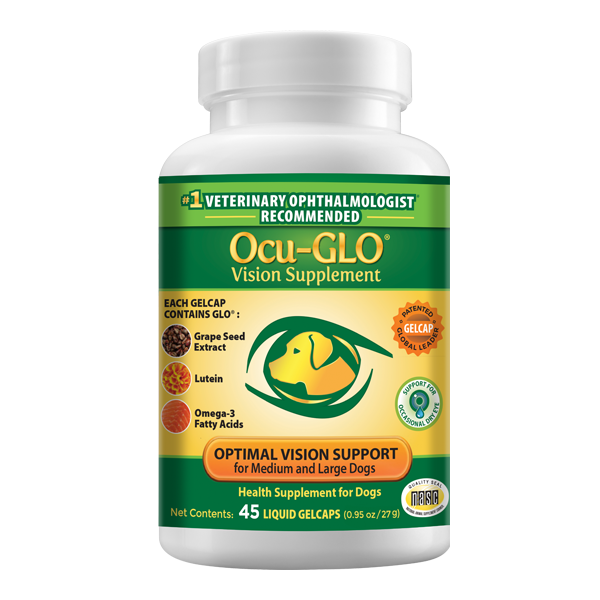
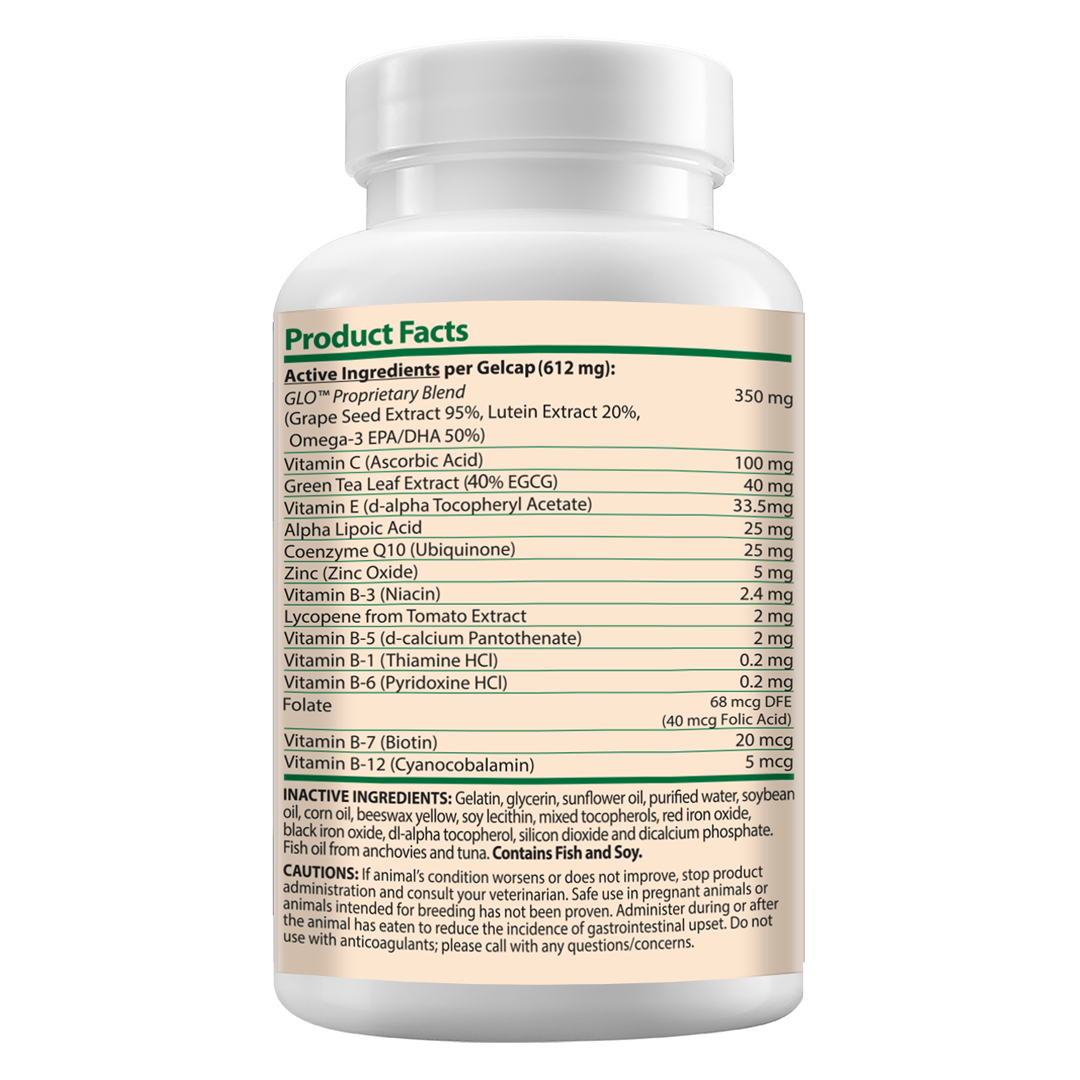
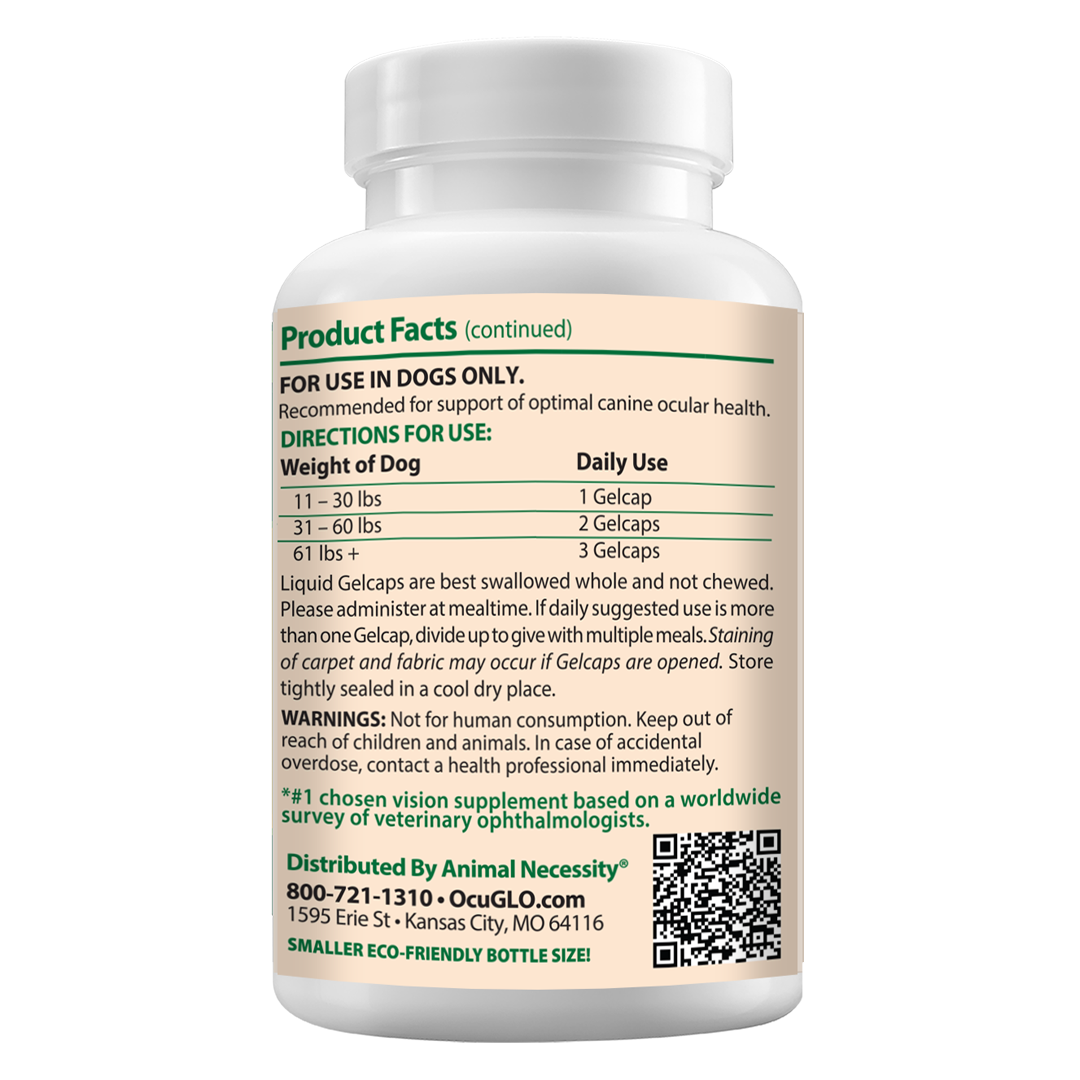
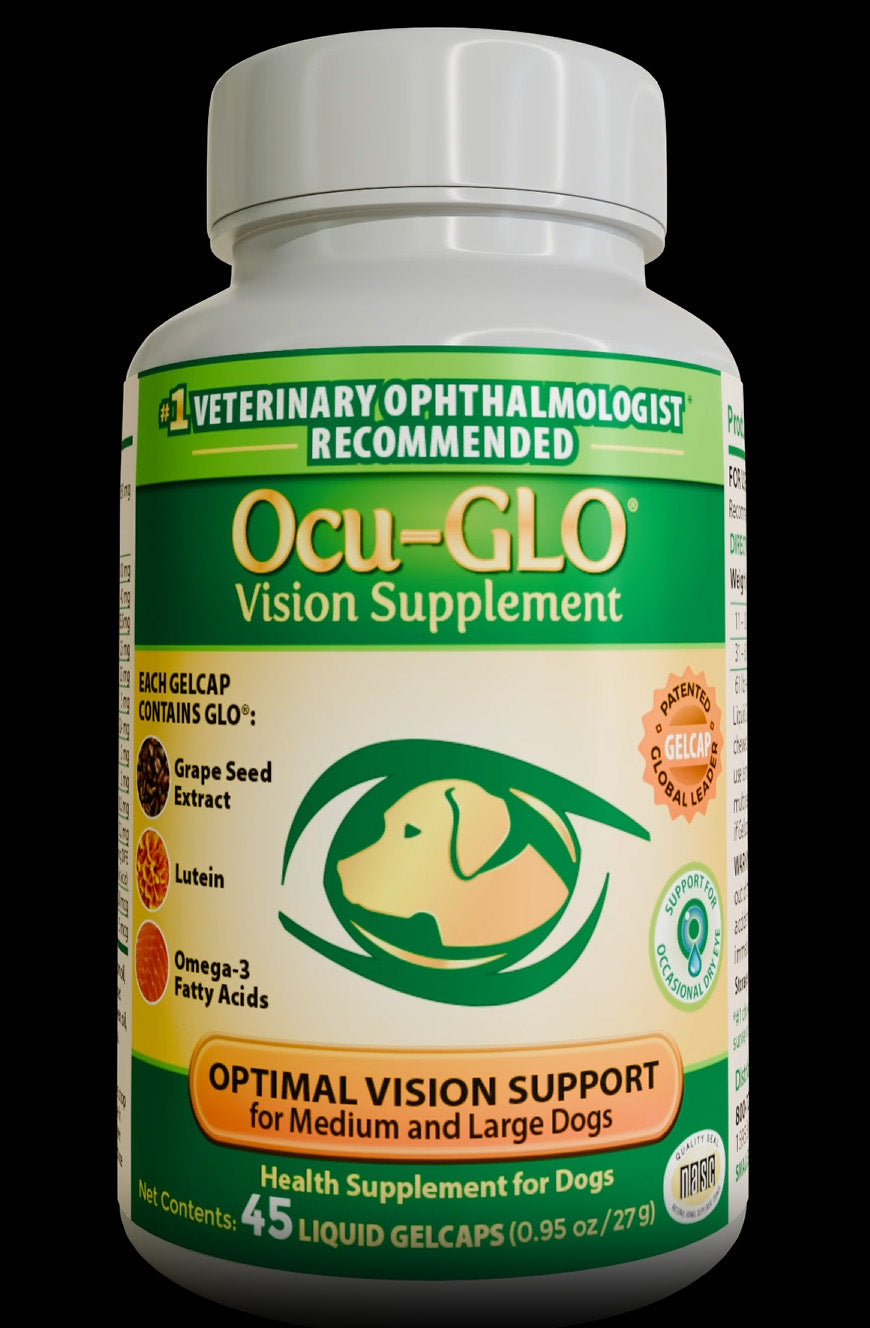
Ocu-GLO® Gelcaps for Medium to Large Dogs (45ct)

If you are a DVM, Clinic, Zoo, or Aquarium, please log in or create an account on our parent website, or call us at 1-800-721-1310 for more information.

Find the right Ocu-GLO® for your pet
Use our matching tool to find the perfect supplement and serving size for your furry friend
The GLO®
To aid in your pet's vision support all our Ocu-GLO® products are founded on three core antioxidants.
Learn moreGrape Seed Extract is rich in antioxidants and proanthocyanidins which support the normal inflammatory response and are powerful free radical scavengers.
Lutein is a carotenoid antioxidant necessary for protection against free radical damage in the cornea, lens, and retina and provides a natural "sunscreen" for the eyes and skin.
Omega-3 fatty acids contain fatty acids EPA and DHA that cannot be made by the body and support retinal health.
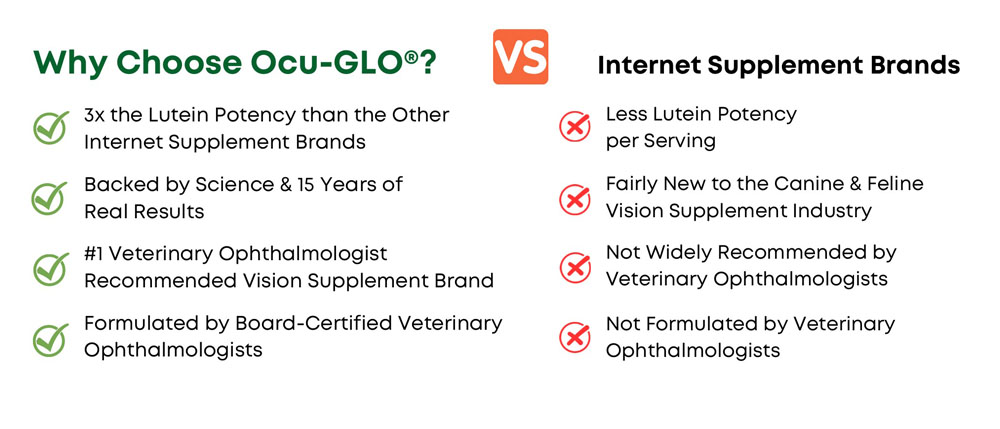
Additional key Ingredients
Vitamin E is found naturally in some foods, added to others, and available as a supplement. Vitamin E is the collective name for a group of fat-soluble compounds that provide antioxidant support.
Like green tea, green tea leaf extract is a great source of antioxidants, credited with a wide range of health benefits. The antioxidants in green tea leaf extract help to support heart, liver, and brain health, as well as supporting healthy skin and overall immune system wellness.
Alpha Lipoic Acid, or ALA, is an occurring antioxidant that's made in the body. Alpha Lipoic Acid is a universal antioxidant that is important for normal liver function and vision.
Vitamin C, also known as ascorbic acid, is a potent water-soluble antioxidant that is necessary for the growth, development, and repair of all body tissues. Vitamin C is vital to your body's healing process.
Information
General Info
Store this product in a cool, dry place (59 - 86 degrees Fahrenheit / 15 - 30 degrees Celsius).
How does Ocu-GLO® differ from everything else in the market?
- Contains 3Xs the Lutein potency of the other internet supplement brands
- Formulated by board certified veterinary ophthalmologists
- Specifically formulated to support canine eyes
- Includes GLO® for optimal vision health: Grape seed extract, Lutein and Omega-3 fatty acids
- No other product delivers all ingredients in one single dose/formulation
- Maintains overall ocular health
Our feline friends have always been extremely hard to pill.
Now that Ocu-GLO® Powder Blend is safe for everyday use in cats, it's very easy to give them the supplement they need! Simply crack open the capsule and sprinkle the powder. Our new formula is great tasting and will go down easily the first time.
Ingredients
Active Ingredients
GLO® Proprietary Blend (Grape Seed Extract 95%, Lutein Extract 20%, Omega-3 EPA/DHA 50%) / 350 mg
Vitamin C (Ascorbic Acid) / 100 mg
Green Tea Extract (40% EGCG) / 40 mg
Vitamin E (d-Alpha Tocopheryl Acetate) / 33.5 mg
Alpha Lipoic Acid / 25 mg
Coenzyme Q10 (Ubiquinone) / 25 mg
Zinc (Zinc Oxide) / 5 mg
Vitamin B-3 (Niacin) / 2.4 mg
Lycopene from Tomato Extract / 2 mg
Vitamin B-5 (d-calcium Pantothenate) / 2 mg
Vitamin B-1 (Thiamine HCI) / 0.2 mg
Vitamin B-6 (Pyridoxine HCI) / 0.2 mg
Folate (40 mcg Folic Acid) / 68 mcg DFE
Vitamin B-7 (Biotin) / 20 mcg
Vitamin B-12 (Cyanocobalamin) / 5 mcg
Inactive Ingredients
Gelatin, glycerin, sunflower oil, purified water, soybean oil, corn oil, beeswax yellow, soy lecithin, mixed tocopherols, red iron oxide, black iron oxide, dl-alpha tocopherol, silicon dioxide and dicalcium phosphate. Fish oil from anchovies and tuna.Contains Fish and Soy.
For Veterinarians
Ocu-GLO® is formulated with different antioxidants that work to support eye health through the quenching of reactive oxygen species (ROS). These active ingredients include:
GLO® Proprietary Blend
- Grape seed extract: Grape seed extract contains different proanthocyanidins such as: catechin, epicatechin and gallic acid, which work to inhibit key components of reactive oxygen species production and stress induced cell signaling in the canine lens epithelium.(1)
- Lutein: Lutein is a carotenoid that has a large body of evidence that supports its antioxidant activity in the eye. Lutein deficiency has been associated with an increased risk of age-related macular degeneration.(2) Lutein supplementation also increases lymphocyte proliferative response and the expression of major hiscompatability complex II (MHC II).(3)
- Omega-3 fatty acids: Omega-3 fatty acids, in the form of eicosapentaenoic acid (EPA) and docosahexaenoic acid (DHA), regulate the inflammatory response, vascular death and regeneration, and photoreceptor apoptosis (cell death) in the eye. A decrease in DHA has been associated with an increase in cytokine-induced proinflammatory signaling in the retina. An increase in both EPA and DHA have been shown to reduce blood vessel damage and hypoxic injury after a retinal insult, as well as reduce photoreceptor apoptosis.(4)
Additional ingredients
- Vitamin C: Vitamin C, in the form of ascorbic acid, is a water soluble vitamin and antioxidant that is vital to the healing process. It is required for neutrophil apoptosis and clearance, and contributes towards collagen synthesis, maturation, secretion, and degradation.(5)
- Green tea leaf extract: Green tea leaf extract is a great source of antioxidants that have been credited with a range of health benefits. Green tea leaf extract contains catechins that have been shown to regulate the inflammatory response in the eye from infectious, non infectious, and oxidative complications.(6)
- Vitamin E: Vitamin E refers to a group of fat-soluble compounds. Supplementation of one of these compounds, α-tocopherol, attacks free radicals to prevent lipid oxidation in retina and other body tissues.(7,8)
- Alpha Lipoic Acid: Alpha Lipoic Acid, or ALA, is an essential cofactor for the synthesis of glutathione, the body’s most potent endogenous antioxidant. ALA and glutathione both work to scavenge free radicals to protect the lens from oxidative stress.(9)
- Coenzyme Q10: Coenzyme Q10, or CoQ-10, is a naturally occurring quinone found in most organisms. CoQ-10 is essential for the health of virtually all tissues since it is involved with the production of adenosine triphosphate (ATP). Decreases in CoQ-10 have been linked to the development diseases that result in an increase in reactive oxygen species (ROS), as its antioxidant activity helps prevent modifications of proteins and DNA by ROS.(10)
- Zinc: Zinc is a mineral that has potent antioxidant activity. Zinc can help protect membranes from iron-initiated lipid oxidation while working synergistically with other antioxidants.(11)
- Lycopene (from tomato extract): Lycopene is a nutritional antioxidant that promotes the synthesis of glutathione, the body’s most potent endogenous antioxidant. Lycopene was statistically significant in a study that showed a reduction in experimentally induced cataracts.(12)
- Vitamin B1 (Thiamin HCl): Vitamin B1 is important for neuromuscular development and aids in cellular metabolism.
- Vitamin B3 (Niacin): Vitamin B3 may help lower serum triglyceride, cholesterol, low density lipoprotein, and very low density lipoprotein levels in the blood.
- Vitamin B5 (d-calcium Pantothenate): Vitamin B5 is essential for the breakdown of fatty acids, amino acids, steroids, and cholesterol. Vitamin B5 also functions as an antioxidant.
- Vitamin B6 (Pyridoxine HCl): Vitamin B6 helps with hemoglobin formation as well as the metabolism of fats, carbohydrates, and proteins.
- Vitamin B7 (Biotin): Biotin is an enzyme cofactor involved in the metabolism of amino acids and the biosynthesis of fats and carbohydrates.
- Vitamin B9 (Folic Acid): Vitamin B9 is important for cell growth and development.
- Vitamin B12 (Cyanocobalamin): Vitamin B12 is an enzyme cofactor that is essential for cell growth and red blood cell development.
References
- Barden CA, Chandler HL, Lu P, Bomser JA, Colitz CMH. 2008. Effect of grape polyphenols on oxidative stress in canine lens epithelial cells. Am J Vet Res 69(1):94-100.
- Bernstein PS, Zhao DY, Wintch SW, Ermakov IV, McClane RW, Gellermann W. 2002. Resonance raman measurement of macular carotenoids in normal subjects and in age-related macular degeneration patients. Ophthalmology 109(10):1780-1787.
- Kim HW, Chew BP, Wong TS, Park JS, Weng BB, Byrne KM, Hayek MG, Reinhart GA. 2000. Dietary lutein stimulates immune response in the canine. Vet Immunol Immunopathol 74(3-4):315-327.
- Querques G, Forte R, Souied ER. 2011. Retina and omega-3. J Nutr Metab 2011:748361.
- Moores J. 2013. Vitamin C: a wound healing perspective. Br J Community Nurs: S8-S11.
- Li J, Du L, He JN, Chu KO, Guo CL, Wong MOM, Pang CP, Chu WK. 2021. Anti-inflammatory effects of GTE in eye diseases. Front Nutr 8:753955.
- Mejia-Fava J, Colitz CMH. 2014. Supplements for exotic pets. Vet Clin Exot Anim 17:503-525.
- Rasmussen HM, Johnson EJ. 2013. Nutrients for the aging eye. Clin Interv Aging 8:741-748.
- Mandelker L, Wynn S. 2004. Cellular effects of common nutraceuticals and natural food substances. Vet Clin Small Anim 34: 339-353.
- Saini R. 2011. Coenzyme Q10: the essential nutrient. J Pharm Bioallied Sci 3(3):466-467.
- Zago MP, Oteiza PI. 2001. The antioxidant properties of zinc: interactions with iron and antioxidants. Free Radic Biol Med 31(2):266-274.
- Gupta SK, Trivedi D, Srivastava S, Joshi S, Halder N, Verma SD. 2003. Lycopene attenuates oxidative stress induced experimental cataract development: an in vitro and in vivo study. Nutrition 19(9):794-799.
Extra Information
Cautions: If animal's condition worsens or does not improve, stop product administration and consult your veterinarian. Safe use in pregnant animals or animals intended for breeding has not been proven. Administer during or after the animal has eaten to reduce incidence of gastrointestinal upset. Do not use if animal is being given anticoagulant medications. Not for use in cats less than one year of age or in any cats with liver disease.
GLO® is a trademark of Animal Health Quest Solutions; Patent US8709515
Store this product in a cool, dry place (59 - 86 degrees Fahrenheit / 15 - 30 degrees Celsius).
How does Ocu-GLO® differ from everything else in the market?
- Contains 3Xs the Lutein potency of the other internet supplement brands
- Formulated by board certified veterinary ophthalmologists
- Specifically formulated to support canine eyes
- Includes GLO® for optimal vision health: Grape seed extract, Lutein and Omega-3 fatty acids
- No other product delivers all ingredients in one single dose/formulation
- Maintains overall ocular health
Our feline friends have always been extremely hard to pill.
Now that Ocu-GLO® Powder Blend is safe for everyday use in cats, it's very easy to give them the supplement they need! Simply crack open the capsule and sprinkle the powder. Our new formula is great tasting and will go down easily the first time.
Active Ingredients
GLO® Proprietary Blend (Grape Seed Extract 95%, Lutein Extract 20%, Omega-3 EPA/DHA 50%) / 350 mg
Vitamin C (Ascorbic Acid) / 100 mg
Green Tea Extract (40% EGCG) / 40 mg
Vitamin E (d-Alpha Tocopheryl Acetate) / 33.5 mg
Alpha Lipoic Acid / 25 mg
Coenzyme Q10 (Ubiquinone) / 25 mg
Zinc (Zinc Oxide) / 5 mg
Vitamin B-3 (Niacin) / 2.4 mg
Lycopene from Tomato Extract / 2 mg
Vitamin B-5 (d-calcium Pantothenate) / 2 mg
Vitamin B-1 (Thiamine HCI) / 0.2 mg
Vitamin B-6 (Pyridoxine HCI) / 0.2 mg
Folate (40 mcg Folic Acid) / 68 mcg DFE
Vitamin B-7 (Biotin) / 20 mcg
Vitamin B-12 (Cyanocobalamin) / 5 mcg
Inactive Ingredients
Gelatin, glycerin, sunflower oil, purified water, soybean oil, corn oil, beeswax yellow, soy lecithin, mixed tocopherols, red iron oxide, black iron oxide, dl-alpha tocopherol, silicon dioxide and dicalcium phosphate. Fish oil from anchovies and tuna.Contains Fish and Soy.
Ocu-GLO® is formulated with different antioxidants that work to support eye health through the quenching of reactive oxygen species (ROS). These active ingredients include:
GLO® Proprietary Blend
- Grape seed extract: Grape seed extract contains different proanthocyanidins such as: catechin, epicatechin and gallic acid, which work to inhibit key components of reactive oxygen species production and stress induced cell signaling in the canine lens epithelium.(1)
- Lutein: Lutein is a carotenoid that has a large body of evidence that supports its antioxidant activity in the eye. Lutein deficiency has been associated with an increased risk of age-related macular degeneration.(2) Lutein supplementation also increases lymphocyte proliferative response and the expression of major hiscompatability complex II (MHC II).(3)
- Omega-3 fatty acids: Omega-3 fatty acids, in the form of eicosapentaenoic acid (EPA) and docosahexaenoic acid (DHA), regulate the inflammatory response, vascular death and regeneration, and photoreceptor apoptosis (cell death) in the eye. A decrease in DHA has been associated with an increase in cytokine-induced proinflammatory signaling in the retina. An increase in both EPA and DHA have been shown to reduce blood vessel damage and hypoxic injury after a retinal insult, as well as reduce photoreceptor apoptosis.(4)
Additional ingredients
- Vitamin C: Vitamin C, in the form of ascorbic acid, is a water soluble vitamin and antioxidant that is vital to the healing process. It is required for neutrophil apoptosis and clearance, and contributes towards collagen synthesis, maturation, secretion, and degradation.(5)
- Green tea leaf extract: Green tea leaf extract is a great source of antioxidants that have been credited with a range of health benefits. Green tea leaf extract contains catechins that have been shown to regulate the inflammatory response in the eye from infectious, non infectious, and oxidative complications.(6)
- Vitamin E: Vitamin E refers to a group of fat-soluble compounds. Supplementation of one of these compounds, α-tocopherol, attacks free radicals to prevent lipid oxidation in retina and other body tissues.(7,8)
- Alpha Lipoic Acid: Alpha Lipoic Acid, or ALA, is an essential cofactor for the synthesis of glutathione, the body’s most potent endogenous antioxidant. ALA and glutathione both work to scavenge free radicals to protect the lens from oxidative stress.(9)
- Coenzyme Q10: Coenzyme Q10, or CoQ-10, is a naturally occurring quinone found in most organisms. CoQ-10 is essential for the health of virtually all tissues since it is involved with the production of adenosine triphosphate (ATP). Decreases in CoQ-10 have been linked to the development diseases that result in an increase in reactive oxygen species (ROS), as its antioxidant activity helps prevent modifications of proteins and DNA by ROS.(10)
- Zinc: Zinc is a mineral that has potent antioxidant activity. Zinc can help protect membranes from iron-initiated lipid oxidation while working synergistically with other antioxidants.(11)
- Lycopene (from tomato extract): Lycopene is a nutritional antioxidant that promotes the synthesis of glutathione, the body’s most potent endogenous antioxidant. Lycopene was statistically significant in a study that showed a reduction in experimentally induced cataracts.(12)
- Vitamin B1 (Thiamin HCl): Vitamin B1 is important for neuromuscular development and aids in cellular metabolism.
- Vitamin B3 (Niacin): Vitamin B3 may help lower serum triglyceride, cholesterol, low density lipoprotein, and very low density lipoprotein levels in the blood.
- Vitamin B5 (d-calcium Pantothenate): Vitamin B5 is essential for the breakdown of fatty acids, amino acids, steroids, and cholesterol. Vitamin B5 also functions as an antioxidant.
- Vitamin B6 (Pyridoxine HCl): Vitamin B6 helps with hemoglobin formation as well as the metabolism of fats, carbohydrates, and proteins.
- Vitamin B7 (Biotin): Biotin is an enzyme cofactor involved in the metabolism of amino acids and the biosynthesis of fats and carbohydrates.
- Vitamin B9 (Folic Acid): Vitamin B9 is important for cell growth and development.
- Vitamin B12 (Cyanocobalamin): Vitamin B12 is an enzyme cofactor that is essential for cell growth and red blood cell development.
References
- Barden CA, Chandler HL, Lu P, Bomser JA, Colitz CMH. 2008. Effect of grape polyphenols on oxidative stress in canine lens epithelial cells. Am J Vet Res 69(1):94-100.
- Bernstein PS, Zhao DY, Wintch SW, Ermakov IV, McClane RW, Gellermann W. 2002. Resonance raman measurement of macular carotenoids in normal subjects and in age-related macular degeneration patients. Ophthalmology 109(10):1780-1787.
- Kim HW, Chew BP, Wong TS, Park JS, Weng BB, Byrne KM, Hayek MG, Reinhart GA. 2000. Dietary lutein stimulates immune response in the canine. Vet Immunol Immunopathol 74(3-4):315-327.
- Querques G, Forte R, Souied ER. 2011. Retina and omega-3. J Nutr Metab 2011:748361.
- Moores J. 2013. Vitamin C: a wound healing perspective. Br J Community Nurs: S8-S11.
- Li J, Du L, He JN, Chu KO, Guo CL, Wong MOM, Pang CP, Chu WK. 2021. Anti-inflammatory effects of GTE in eye diseases. Front Nutr 8:753955.
- Mejia-Fava J, Colitz CMH. 2014. Supplements for exotic pets. Vet Clin Exot Anim 17:503-525.
- Rasmussen HM, Johnson EJ. 2013. Nutrients for the aging eye. Clin Interv Aging 8:741-748.
- Mandelker L, Wynn S. 2004. Cellular effects of common nutraceuticals and natural food substances. Vet Clin Small Anim 34: 339-353.
- Saini R. 2011. Coenzyme Q10: the essential nutrient. J Pharm Bioallied Sci 3(3):466-467.
- Zago MP, Oteiza PI. 2001. The antioxidant properties of zinc: interactions with iron and antioxidants. Free Radic Biol Med 31(2):266-274.
- Gupta SK, Trivedi D, Srivastava S, Joshi S, Halder N, Verma SD. 2003. Lycopene attenuates oxidative stress induced experimental cataract development: an in vitro and in vivo study. Nutrition 19(9):794-799.
Cautions: If animal's condition worsens or does not improve, stop product administration and consult your veterinarian. Safe use in pregnant animals or animals intended for breeding has not been proven. Administer during or after the animal has eaten to reduce incidence of gastrointestinal upset. Do not use if animal is being given anticoagulant medications. Not for use in cats less than one year of age or in any cats with liver disease.
GLO® is a trademark of Animal Health Quest Solutions; Patent US8709515
Suggested daily use
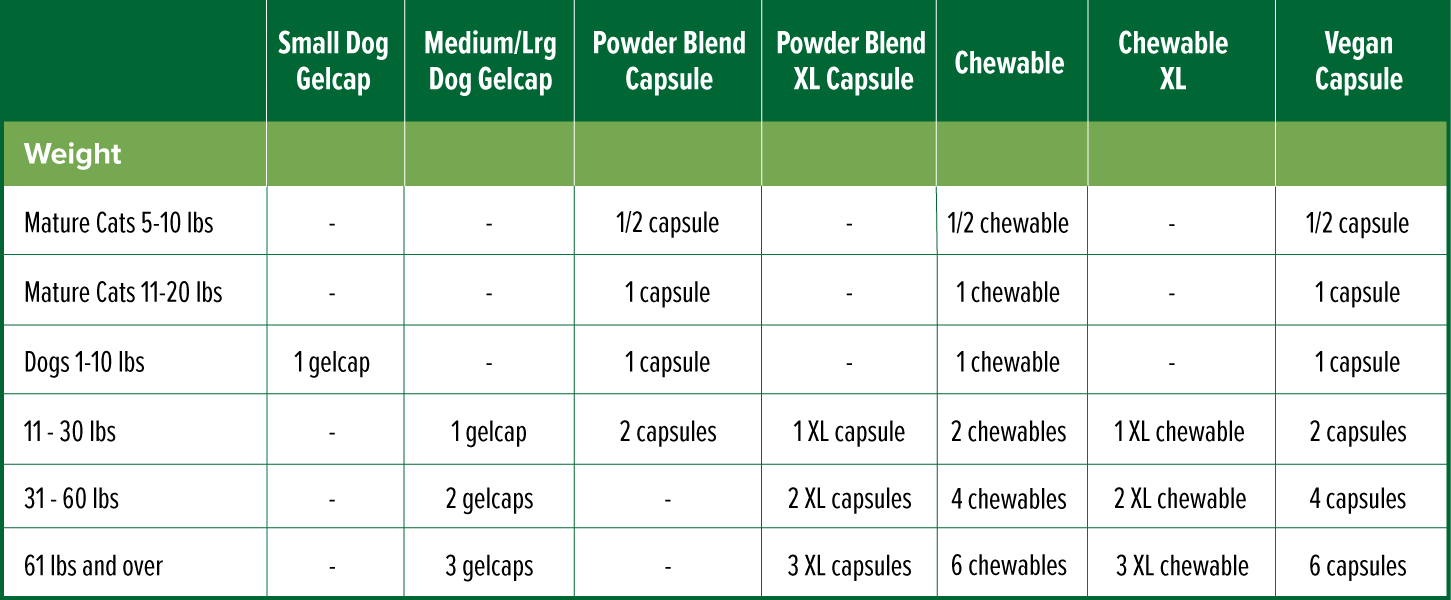
Never for use in cats under five pounds, cats less than one year of age, or any cats with liver disease.
Liquid Gelcaps are best swallowed whole and not chewed. Please administer at mealtime.
Staining of carpet and fabric may occur if Gelcaps are opened. Store tightly sealed in a cool dry place.
Warning: For animal use only. Keep out of reach of children and animals. In case of accidental overdose, contact a health professional immediately.
Have a question about Ocu-GLO®?
Please visit our Frequently Asked Questions or Contact Us.

